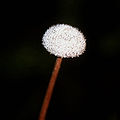| Eriocaulaceae | |
|---|---|

| |
| Eriocaulon decangulare 1832 illustration | |
| Scientific classification | |
| Kingdom: | Plantae |
| Clade: | Tracheophytes |
| Clade: | Angiosperms |
| Clade: | Monocots |
| Clade: | Commelinids |
| Order: | Poales |
| Family: | Eriocaulaceae Martinov |
| Genera | |
|
See text | |
The Eriocaulaceae are a family of monocotyledonous flowering plants in the order Poales, commonly known as the pipewort family. The family is large, with about 1207 known species described in seven genera. They are widely distributed, with the centers of diversity for the group occurring in tropical regions, particularly the Americas. Very few species extend to temperate regions, with only 16 species in the United States, mostly in the southern states from California to Florida, only two species in Canada, and only one species (Eriocaulon aquaticum) in Europe. They tend to be associated with wet soils, many growing in shallow water. This is also reported from the southern part of India and the regions of Western Ghats hot spots.
The species are mostly herbaceous perennial plants, though some are annual plants; they resemble plants in the related families Cyperaceae (sedges) and Juncaceae (rushes), and like them, have rather small, wind-pollinated flowers grouped together in capitulum-like inflorescences.
- Genera
- Actinocephalus
- Comanthera
- Coracoralina
- Cryptanthella
- Eriocaulon - pipewort
- Floralia
- Giuliettia
- Gnomus
- Hydriade
- Lachnocaulon - bogbutton
- Leiothrix
- Mesanthemum
- Monosperma
- Nisius
- Paepalanthus
- Rondonanthus
- Syngonanthus
- Tonina
The Eriocaulaceae Book
Eriocaulaceae are fascinating plants, especially popular in South America, where they shape iconic and typical landscapes with their unique beauty and captivating diversity.
In 2024, the book "The World of Eriocaulaceae: Everlastings, Pipeworts, and Golden Grass" (O mundo das Eriocaulaceae: sempre-vivas, chuveirinhos e capim-dourado), a bilingual work, was presented during the 74th Brazilian National Botany Congress. This book brings together the contributions of 16 researchers from various institutions around the world, organized into chapters that explore different aspects of the Eriocaulaceae family. Edited by experts Dr. Caroline Oliveira Andrino and Dr. Fabiana Nepomuceno da Costa, the work combines scientific rigor with accessible language, making it an engaging read for scientists, nature enthusiasts, and the general public alike.
In addition to offering detailed information on the diversity and distribution of these plants, the book also delves into the significant use of Eriocaulaceae by traditional communities. These cultural and ecological connections highlight the value of these plants not only to science but also to local ways of life. Filled with stunning photographs captured by attentive eyes and skilled lenses, the book provides a visual and informative journey through the landscapes that host these extraordinary plants, showcasing species from different parts of the world.
See also
References
- Angiosperm Phylogeny Group (2009). "An update of the Angiosperm Phylogeny Group classification for the orders and families of flowering plants: APG III". Botanical Journal of the Linnean Society. 161 (2): 105–121. doi:10.1111/j.1095-8339.2009.00996.x. hdl:10654/18083. Archived from the original (PDF) on 2017-05-25. Retrieved 2013-06-26.
- "From: Curtis's botanical magazine; or flower garden displayed. London, 1832, volume 59 (plate 3126)". Archived from the original on 2006-10-23. Retrieved 2014-08-12.
- Christenhusz, M. J. M.; Byng, J. W. (2016). "The number of known plants species in the world and its annual increase". Phytotaxa. 261 (3). Magnolia Press: 201–217. doi:10.11646/phytotaxa.261.3.1.
External links
| Taxon identifiers | |
|---|---|
| Eriocaulaceae |
|

